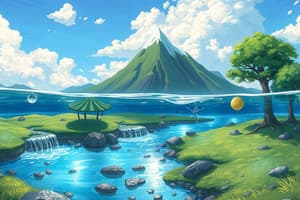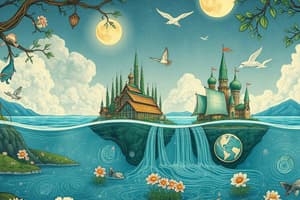Podcast
Questions and Answers
What percentage of Earth's water is freshwater?
What percentage of Earth's water is freshwater?
- 1%
- 10%
- 3% (correct)
- 12%
Which process in the water cycle involves water vapor cooling to form clouds?
Which process in the water cycle involves water vapor cooling to form clouds?
- Precipitation
- Evaporation
- Condensation (correct)
- Collection
What is a primary use of water in agriculture?
What is a primary use of water in agriculture?
- Cooling machinery
- Manufacturing goods
- Irrigating crops (correct)
- Filling recreational facilities
What best describes domestic trade?
What best describes domestic trade?
Which of the following is a factor that affects trade?
Which of the following is a factor that affects trade?
Which of the following is an advantage of trade?
Which of the following is an advantage of trade?
What is primarily transported by various modes in trade?
What is primarily transported by various modes in trade?
What natural resource is most associated with freshwater availability?
What natural resource is most associated with freshwater availability?
Flashcards
Ocean Water
Ocean Water
Most of Earth's water (97%) exists as saltwater found in oceans.
Freshwater
Freshwater
Freshwater makes up only 3% of Earth's water. Most of it is frozen in glaciers and ice caps.
Water Cycle
Water Cycle
The continuous movement of water on, above, and below the surface of the Earth.
Evaporation
Evaporation
Signup and view all the flashcards
Trade
Trade
Signup and view all the flashcards
Domestic Trade
Domestic Trade
Signup and view all the flashcards
Transportation in Global Trade
Transportation in Global Trade
Signup and view all the flashcards
Politics in Trade
Politics in Trade
Signup and view all the flashcards
Study Notes
Water in the World
- Ninety-seven percent of Earth's water is saltwater contained in oceans.
- Only three percent is freshwater, primarily locked in glaciers and ice caps, with the remainder found in rivers, lakes, and groundwater.
- The water cycle involves evaporation (water turning to vapor), condensation (vapor turning to clouds), precipitation (water falling as rain, snow, etc.), and collection (water gathering in bodies of water).
Interconnection of Trade
- Trade involves the exchange of goods and services between individuals, businesses, or nations.
- Domestic trade occurs within a country, while international trade involves exchanges between countries, including imports (goods coming in) and exports (goods leaving).
- Global trade networks use various routes (historical, like the Silk Road, and modern shipping lanes) and transportation methods (ships, planes, trains, trucks).
- Geographic factors (resources, climate, location), economic factors (strength, technology, infrastructure), and political factors (trade policies, tariffs) all influence trade.
- Benefits of trade include economic growth, cultural exchange, and improved access to a wider variety of goods.
- Potential challenges include economic dependency, environmental impact (pollution and habitat destruction), and inequality in economic benefits.
Studying That Suits You
Use AI to generate personalized quizzes and flashcards to suit your learning preferences.




